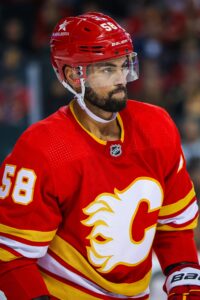Last updated 8/26/24, 8:25 a.m.
The 2025 NHL Draft may still be nearly a year away, but multiple teams have already traded away their first-round picks, and even more will change hands before the March 6, 2025 trade deadline.
This article will be used to monitor each team’s 2025 first-round pick, updating it as necessary throughout the year.
We’ve listed all 32 teams here, so even if a team hasn’t traded its first-round pick, that will be noted. We’ll also provide details on the protections for each traded pick, including what happens to the pick in 2026 if it doesn’t change hands in 2025.
Here’s the full breakdown of the status of each 2025 first-round pick:
Atlantic
- Boston Bruins: Own pick.
- Buffalo Sabres: Own pick.
- Detroit Red Wings: Own pick.
- Florida Panthers: Traded to Flames or Canadiens (top-10 protected).
- If this pick lands in its protected range, the Panthers would owe the Flames their 2026 first-round pick (unprotected).
- Flames/Panthers details are outlined below.
- Montreal Canadiens: Own pick.
- Ottawa Senators: Own pick.
- Tampa Bay Lightning: Traded to Predators (top-10 protected).
- If this pick lands in its protected range, the Lightning would owe the Predators their 2026 first-round pick (unprotected).
- Toronto Maple Leafs: Traded to Blackhawks (top-10 protected).
- If this pick lands in its protected range, the Maple Leafs would owe the Blackhawks their 2026 first-round pick (unprotected).
Metropolitan
- Carolina Hurricanes: Own pick.
- Columbus Blue Jackets: Own pick.
- New Jersey Devils: Traded to Flames (top-10 protected).
- If this pick lands in its protected range, the Devils would owe the Flames their 2026 first-round pick (unprotected).
- New York Islanders: Own pick.
- New York Rangers: Own pick.
- Philadelphia Flyers: Own pick.
- Pittsburgh Penguins: Own pick.
- Washington Capitals: Own pick.
Central
- Chicago Blackhawks: Own pick.
- Colorado Avalanche: Traded to Flyers (top-10 protected).
- If this pick lands in its protected range, the Avalanche would owe the Flyers their 2026 first-round pick (unprotected).
- Dallas Stars: Own pick.
- Minnesota Wild: Own pick.
- Nashville Predators: Own pick.
- St. Louis Blues: Own pick.
- Utah Hockey Club: Own pick.
- Winnipeg Jets: Own pick.
Pacific
- Anaheim Ducks: Own pick.
- Calgary Flames: Traded to Canadiens or own pick.
- Flames/Canadiens details are outlined below.
- Edmonton Oilers: Traded to Flyers (top-12 protected).
- If this pick lands in its protected range, the Oilers would owe the Flyers their 2026 first-round pick (unprotected).
- Los Angeles Kings: Own pick.
- San Jose Sharks: Own pick or traded to Predators.
- Details are outlined under the Golden Knights’ pick.
- Seattle Kraken: Own pick.
- Vancouver Canucks: Own pick.
- Vegas Golden Knights: Traded to Predators or Sharks. (unprotected).
- This pick was initially traded to the Sharks without protection. The Sharks later dealt this pick to the Predators, but San Jose can opt to retain Vegas’ pick and send their own 2025 first-rounder to Nashville if Vegas’ pick falls inside the top 10.
Details on Flames’ picks:
Remember all those complex conditions attached to the first-round pick the Flames sent to the Canadiens to take on the final season of Sean Monahan’s contract in 2022? Those will come back to bite draft-watchers this season. A full explanation of all the possible conditions can be found in this write-up from two years ago, but we’ll outline them briefly here.
In 2025, the Flames control three first-rounders:
- Their own.
- The Panthers’ first-round pick (top-10 protected).
- The Devils’ first-round pick (top-10 protected).
Luckily for those trying to parse through the conditions of the trade, the Devils’ pick, which Calgary acquired in this offseason’s Jacob Markstrom trade, isn’t a factor here.
At the time of the Monahan deal, there were three possible scenarios to determine which first-round pick the Habs would receive. One of them can already be crossed off, as it involved the Canadiens opting to receive Calgary’s 2024 first-rounder if it fell between 20th and 32nd overall. It didn’t, so we moved on to the other scenarios.
With Calgary likely to be a bottom-feeder this season and Florida coming off a Stanley Cup championship, the most likely scenario is that the Flames’ first-rounder falls inside the top 10 and the Panthers’ does not. In that case, the Canadiens will receive Florida’s pick. The opposite would be true if the situation was reversed. If neither pick falls in the top 10, the Canadiens will receive the better of the two picks.
The write-up linked above details the third scenario, which involves both picks falling inside the top 10.
Information from PuckPedia was used in the creation of this post.

